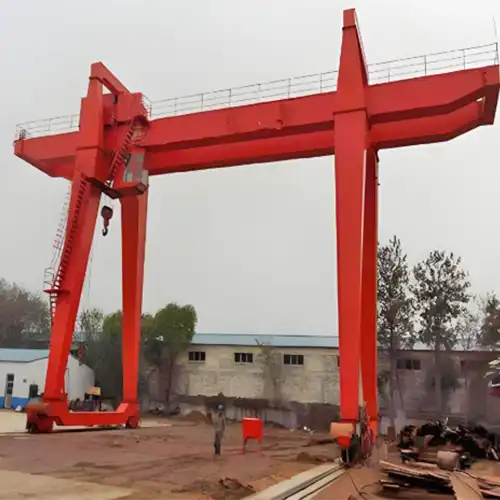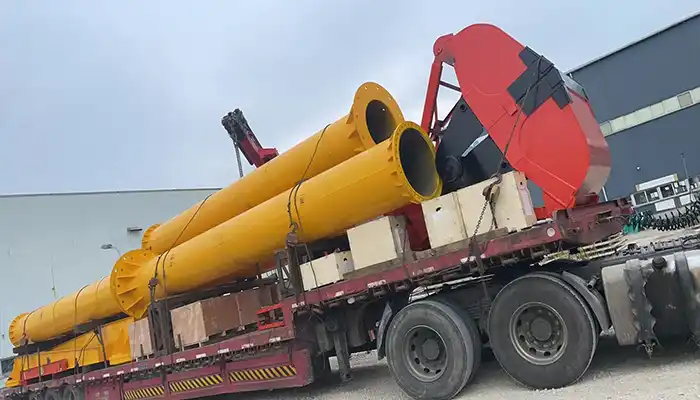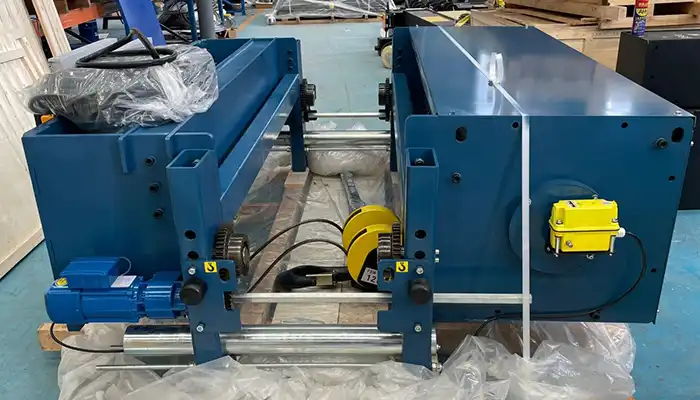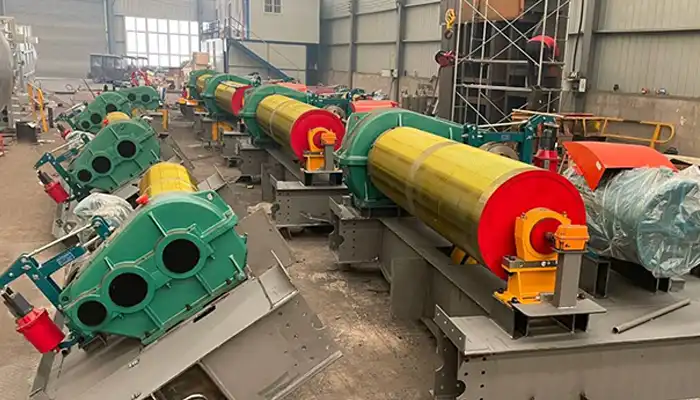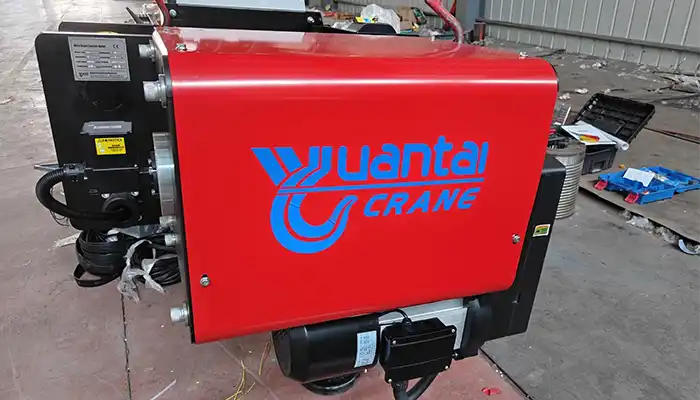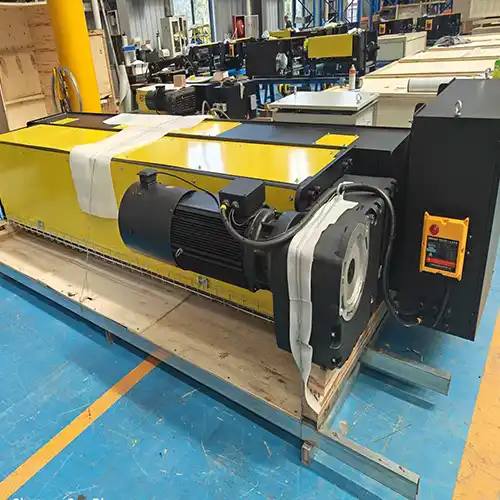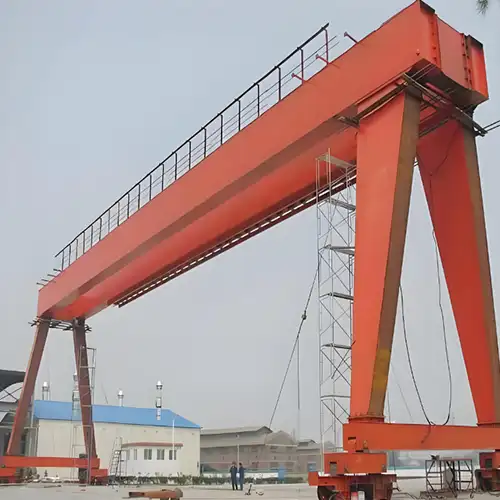32 Ton Gantry Crane for Battery Cabinet Maintenance & Replacement
Streamlining battery cabinet maintenance with 32-ton gantry cranes enhances efficiency, reduces downtime, and improves safety in energy storage facilities.
Category: Featured
Your Trusted Gantry Crane Manufacturer & Supplier
32 Ton Gantry Crane for Battery Cabinet Maintenance & Replacement
Streamlining battery cabinet maintenance with 32-ton gantry cranes enhances efficiency, reduces downtime, and improves safety in energy storage facilities.
Overview of Energy Storage Facilities and Their Importance
Energy storage facilities are critical for stabilizing the grid, especially with the rise of renewable energy sources like solar and winThese facilities store excess energy during times of high production and release it when demand increases. This helps balance supply and demand, lowers energy costs, and supports a cleaner energy future.
As the energy industry grows, so do the storage systems. They're getting larger, more complex, and more advanceBut with this growth comes the need for reliable and efficient maintenance. The key to this efficiency is maintaining and replacing the battery cabinets, which are at the core of these systems.
The Need for Efficient Maintenance and Replacement of Battery Cabinets
Battery cabinets are essential for energy storage. Over time, these batteries wear out and need to be serviced or replaceWithout proper maintenance, battery performance drops, and the system becomes less reliable.
However, maintenance and replacement can be time-consuming and labor-intensive. Delays in these tasks can lead to higher costs, increased downtime, and operational inefficiencies. Finding ways to make these processes faster and more efficient is crucial to keep the energy storage systems running smoothly.
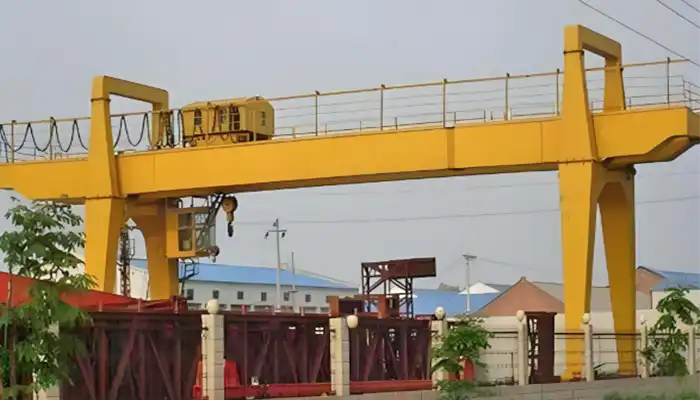
Role of Gantry Cranes in Streamlining Operations
Gantry cranes are playing a key role in making the maintenance and replacement of battery cabinets more efficient. These cranes are designed to handle heavy loads, with capacities ranging from 30 to 80 tons, making them perfect for lifting and moving large battery cabinets.
By using gantry cranes, energy storage facilities can:
- Reduce manual labor
- Speed up maintenance and replacement tasks
- Cut down on operational downtime
The ability of European style double girder gantry cranes to automate and precisely control the movement of cabinets makes them an essential tool for streamlining operations in energy storage facilities. Their use not only boosts efficiency but also improves safety and reduces the risk of human error.
Energy Storage Cabinets and Maintenance Requirements
Energy Storage Cabinets Overview
Components and Battery Types
Energy storage cabinets house battery modules and essential components to store and manage energy. The cabinets are equipped with various parts like battery modules, electrical connections, cooling systems, and safety features. The most common battery types used in these systems are:
- Lithium-Ion Batteries: Preferred for their high energy density, long lifespan, and consistency in performance. These batteries are commonly used in large-scale applications like grid storage.
- Lead-Acid Batteries: Although older and less efficient than lithium-ion batteries, they are still used due to their lower initial cost.
- Solid-State Batteries: Emerging technology offering higher energy density and better safety, likely to become more widespread as the technology matures.
These cabinets are designed to keep the batteries safe, with cooling systems to regulate temperature and prevent overheating, fire suppression mechanisms, and sensors to monitor battery conditions.
Maintenance Tasks and Challenges
Maintaining energy storage cabinets involves several critical tasks:
- Battery Replacement: Batteries lose capacity over time, particularly through charging and discharging cycles. Once they reach the end of their useful life, they must be removed and replaceThis involves handling multiple battery modules and ensuring they are correctly replaced with newer units.
- Checking Electrical Connections: Battery modules are interconnected through various wiring systems that must be regularly inspected for wear, corrosion, and overheating.
- Cooling System Checks: The cooling system ensures batteries remain at optimal temperatures during operation. Any malfunction can cause overheating, shortening the life of the batteries.
- Software and Calibration Updates: Energy storage systems often use software to monitor battery performance. Routine updates and calibrations are needed to ensure these systems operate at peak efficiency.
The main challenge in this process is the heavy, bulky nature of the batteries and modules, which can make maintenance cumbersome without the proper equipment.
Evolution of Battery Technologies and the Need for Replacements
Battery technologies have progressed significantly in recent years, leading to better energy storage solutions with improved efficiency, capacity, and safety. Initially, lead-acid batteries were the standard in energy storage, but lithium-ion batteries have taken over due to their superior energy density and longer lifespans. However, even lithium-ion batteries degrade over time, requiring eventual replacement.
As battery technologies evolve, newer chemistries, such as solid-state batteries, are being developed, offering even better performance and safety. The need for replacement arises not only due to the natural degradation of batteries over time but also because emerging technologies may offer greater efficiency, requiring energy storage facilities to replace older battery systems with newer, more advanced ones.
Replacing older batteries with new technologies often involves adapting the energy storage cabinets to accommodate batteries that may be of different sizes, shapes, or cooling requirements, creating further challenges for operators.
Maintenance Cycles and the Need for Efficiency
The success of an energy storage facility hinges on efficient maintenance cycles. Regular maintenance ensures that systems continue to operate without unexpected disruptions, which can be costly and time-consuming. Maintenance activities typically follow two broad categories:
- Routine Inspections: These are scheduled checks of battery performance, electrical connections, cooling systems, and software updates. By keeping up with these tasks, operators can prevent small issues from becoming larger problems.
- Major Overhauls and Replacements: This involves more extensive maintenance, including the replacement of batteries, modules, and other critical components that have reached the end of their lifecycle.
Predictive maintenance technologies, such as real-time monitoring and diagnostic systems, help anticipate when these tasks are needed by tracking performance metrics and battery health. These technologies can alert operators to early signs of degradation, reducing the risk of unplanned downtime and allowing for timely replacements.
Efficient maintenance not only minimizes downtime but also lowers costs. By identifying and addressing issues early, operators can reduce the need for emergency repairs, avoid costly replacements, and extend the lifespan of energy storage systems. Gantry cranes play an essential role in improving maintenance efficiency. These cranes allow operators to quickly and safely handle heavy batteries and components, reducing the time and labor required to complete maintenance tasks and ensuring that replacements are carried out smoothly.
By streamlining maintenance processes, operators can enhance both the safety and performance of their energy storage systems, ensuring that the facility remains operational with minimal disruptions.
Gantry Cranes in Energy Storage Facilities
Crane Capacity and Its Relationship to Cabinet Sizes
Typical Load Handling (30 to 80 Tons)
Gantry cranes in energy storage facilities are designed to handle varying load capacities, typically ranging from 30 tons to 80 tons. The specific capacity needed depends on the size and weight of the energy storage cabinets, which can vary greatly depending on the number and type of batteries inside.
- Smaller Systems: For smaller storage systems, like those used in commercial or residential setups, a crane with a 30-ton capacity is generally sufficient to lift and move cabinets.
- Larger Systems: For industrial-scale facilities, where storage cabinets may house more batteries or larger battery modules, a higher crane capacity, like 80 tons, is needed to handle the increased weight and size of the equipment.
This range of crane capacities ensures that the facility can move a wide variety of energy storage cabinets without overloading the crane or risking damage to the components.
Impact of Crane Capacity on Maintenance Operations
The right crane capacity directly influences the efficiency and safety of maintenance operations in energy storage facilities.
- Improved Efficiency: Cranes with the appropriate capacity allow for smoother handling of energy storage cabinets, making it quicker and easier to remove and replace batteries or modules during routine maintenance.
- Reduced Downtime: A crane with enough lifting power ensures that maintenance tasks are completed faster, reducing downtime and helping the facility maintain consistent energy storage capacity.
- Enhanced Safety: Using a crane with the correct load capacity also ensures that the cabinets are lifted and transported without risk of accidents or overloading the crane, which could lead to injury or equipment failure.
Advantages of Using Double Girder Gantry Cranes
Versatility in Handling Different Sizes of Energy Storage Cabinets
Double girder gantry cranes provide significant versatility, making them ideal for handling a variety of energy storage cabinets, both small and large. Unlike single girder cranes, which are typically limited in lifting capacity, double girder cranes offer greater strength and stability, allowing them to manage heavier loads with ease.
- Wide Range of Applications: Double girder cranes are well-suited for energy storage facilities where cabinets of different sizes need to be moveThe ability to handle both smaller, lighter cabinets and larger, heavier ones with a single crane simplifies operations.
- Adaptability to Changing Needs: As the technology in energy storage evolves, cabinets may increase in size or weight to accommodate more advanced batteries. Double girder gantry cranes can be adapted or upgraded to handle these changes, providing long-term flexibility for the facility.
Efficiency in Reducing Manual Labor
One of the primary advantages of using double girder gantry cranes in energy storage facilities is the reduction in manual labor required for moving heavy equipment. These cranes are designed to lift, transport, and position cabinets with minimal human intervention, which not only boosts productivity but also improves safety.
- Automation and Precision: Double girder gantry cranes are often equipped with automated features that ensure precise lifting and placement of cabinets. This eliminates the need for workers to handle heavy loads manually, reducing the risk of strain or injury.
- Labor Savings: By reducing the reliance on manual lifting, the crane allows staff to focus on other essential tasks, like inspections or battery replacements, instead of spending time on physically demanding jobs.
Minimizing Downtime in Energy Storage Operations
Downtime is a significant concern in energy storage facilities, as any interruption in service can affect the reliability and efficiency of the overall system. Double girder gantry cranes play an essential role in minimizing this downtime by speeding up the maintenance process.
- Faster Handling: The strong lifting capacity of double girder cranes enables quick removal and replacement of battery cabinets, reducing the time spent on each maintenance cycle.
- Continuous Operation: Because these cranes can handle heavy loads efficiently, maintenance can be carried out more quickly, allowing the energy storage facility to return to full capacity faster.
- Reduced Operational Delays: With faster, more efficient handling, the facility can minimize any delays caused by maintenance, ensuring that energy storage operations continue smoothly and that power supply remains uninterrupted.
In summary, double girder gantry cranes provide significant benefits to energy storage facilities by improving the efficiency, safety, and versatility of maintenance operations. Their ability to handle a wide range of cabinet sizes and reduce manual labor helps optimize facility operations, minimize downtime, and ensure that the energy storage system operates at peak performance.
Specific Applications of Gantry Cranes in Battery Cabinet Maintenance
Removal of Energy Storage Cabinets from Racks
Automated Systems for Precision Handling
Gantry cranes, especially those equipped with automated systems, are essential for removing energy storage cabinets from racks with precision. These systems are designed to lift, move, and position heavy battery cabinets with minimal manual intervention. Automated cranes are equipped with advanced sensors, control systems, and cameras that ensure accurate alignment, smooth operation, and safe handling of the cabinets during the removal process.
- Enhanced Precision: Automated systems reduce the chances of human error, ensuring that cabinets are precisely positioned and safely lifted from their storage racks. This minimizes the risk of accidental damage to the battery modules or the racks themselves.
- Consistency: Automated processes provide consistent and repeatable results, making the removal process more reliable and efficient over time.
Crane Maneuverability and Ease of Transport
Gantry cranes are designed to move with high maneuverability, allowing them to efficiently navigate the often constrained spaces in energy storage facilities. Their ability to move in multiple directions, combined with a controlled lifting mechanism, ensures that energy storage cabinets can be quickly and easily removed from their storage racks.
- Compact Design: Gantry cranes can be designed to fit within narrow aisles or tight spaces, making them ideal for areas where space is limited.
- Efficient Movement: With their ability to move along tracks or rails, these cranes can easily transport cabinets from one location to another without the need for complex or manual repositioning.
Transport to Servicing Areas for Maintenance and Replacement
Once the energy storage cabinets are removed from the racks, gantry cranes are used to transport them to designated servicing areas for inspection, maintenance, or replacement. This phase involves safely moving the cabinets across the facility while ensuring that they are not exposed to environmental risks or subjected to excessive vibration, which could damage the delicate battery modules inside.
- Smooth and Controlled Transport: Cranes equipped with precision controls allow operators to transport the cabinets smoothly, ensuring that the batteries are not subjected to unnecessary stress.
- Timely Operations: The crane's efficiency in moving cabinets to servicing areas helps minimize downtime and maintain continuous operation in the facility, enabling maintenance to be completed quickly and effectively.
Reinstallation of Serviced or New Cabinets
After maintenance or battery replacement, the gantry crane is used to reinstall the serviced or new energy storage cabinets back into their designated racks. This process requires the crane to handle the cabinets delicately to avoid damage to the newly serviced batteries or modules.
- Safe Reinstallation: The crane's lifting mechanisms ensure that the cabinets are carefully lowered into place, reducing the risk of damage during installation. Automated systems ensure accurate positioning, so the cabinets fit properly into their storage racks.
- Quick Turnaround: Efficient reinstallation of cabinets is crucial for reducing downtime in the energy storage facility. Gantry cranes allow the process to be completed quickly and smoothly, facilitating rapid return to service.
Remote Monitoring and Control for Efficiency and Safety
Modern gantry cranes often come equipped with remote monitoring and control systems, which significantly enhance both operational efficiency and safety during battery cabinet maintenance.
- Real-Time Monitoring: Operators can remotely monitor the crane's performance and the status of the energy storage cabinets being moveThis allows for quicker detection of potential issues, such as incorrect positioning or operational errors, enabling immediate corrective actions to be taken.
- Safety Features: Remote control systems also provide additional safety features, such as emergency stop functions, load sensors to avoid overloading, and real-time diagnostics that alert operators to mechanical or electrical malfunctions before they can cause issues.
- Increased Efficiency: Remote monitoring and control also enable operators to optimize crane usage, adjusting parameters such as speed, load capacity, and path to maximize efficiency during the maintenance process.
By integrating these advanced technologies, energy storage facilities can further enhance the safety, precision, and efficiency of their battery cabinet maintenance operations. Gantry cranes with remote monitoring ensure that the entire process, from removal to reinstallation, is streamlined and secure, helping to minimize operational downtime and optimize the lifespan of the energy storage system.
Specific Applications of Gantry Cranes in Battery Cabinet Maintenance
Removal of Energy Storage Cabinets from Racks
Automated Systems for Precision Handling
When removing energy storage cabinets from storage racks, precision is crucial to avoid damage to the cabinets and their delicate internal components. Gantry cranes are often integrated with automated systems that allow for precise lifting and positioning. These systems use sensors, cameras, and automated controls to ensure that the crane moves the cabinet accurately without any jerky movements that could harm the batteries or the cabinet itself.
- Smart Sensors: These sensors detect the weight distribution and balance of the cabinets, ensuring that they are lifted evenly and safely.
- Automated Adjustments: Automated control systems adjust the crane's movements based on real-time data to optimize the lifting process, ensuring smooth and controlled handling.
Crane Maneuverability and Ease of Transport
Gantry cranes are designed for exceptional maneuverability, enabling operators to navigate tight spaces in energy storage facilities with ease. This is particularly important in environments where storage racks are packed closely together, and there is limited space to move.
- High Precision: Gantry cranes equipped with advanced hoisting and positioning systems can navigate complex environments, ensuring that energy storage cabinets are efficiently removed from their racks.
- Flexible Movement: The crane's ability to travel across the facility on tracks or wheels ensures that cabinets can be moved to different locations without difficulty, helping reduce operational disruptions.
Transport to Servicing Areas for Maintenance and Replacement
Once the energy storage cabinets are removed from their storage racks, gantry cranes play a vital role in transporting them to designated servicing areas where they undergo maintenance or replacement.
- Seamless Transport: The crane's precise movement allows the cabinets to be carefully transported through the facility without causing damage. The transport is done efficiently, reducing downtime and speeding up the overall maintenance process.
- Adaptability: Depending on the facility's design, the crane can be used to transport the cabinets across various sections, whether they are positioned near battery module inspection areas, charging stations, or other maintenance zones.
- Safety: As the crane transports the cabinets, its systems ensure stability, preventing tipping or accidents during movement, even when navigating through narrow aisles or corners.
Reinstallation of Serviced or New Cabinets
After the maintenance is complete, gantry cranes are also responsible for reinstalling either the serviced or new energy storage cabinets back into their original storage locations or to new spots as needed.
- Precise Repositioning: Gantry cranes allow for accurate placement of cabinets back into their racks, ensuring that they are aligned correctly to avoid future issues.
- Minimizing Stress on Components: During reinstallation, the crane's ability to gently place the cabinet prevents unnecessary stress on the battery modules and the overall structure, preserving the integrity of the system.
- Streamlined Operations: With the help of automation and precise control, the crane reinstallation process becomes quick and efficient, allowing the facility to resume full operation with minimal delay.
Remote Monitoring and Control for Efficiency and Safety
Remote monitoring and control systems further enhance the efficiency and safety of gantry crane operations. These systems allow operators to oversee the crane's performance and make adjustments as needed without being physically present.
- Real-Time Data: Remote monitoring systems collect and display critical data such as load weight, crane speed, and positioning. This information helps operators track the crane's performance and adjust its movements in real-time.
- Safety Features: Remote control systems can also trigger safety protocols, such as automatic halting if the crane detects any irregularities, such as excessive load or misalignment, preventing potential accidents.
- Increased Efficiency: By having control over the crane's functions from a distance, operators can optimize the workflow, reduce human error, and streamline maintenance procedures.
Remote monitoring and control systems also enhance the ability to troubleshoot any issues in the crane's operation, ensuring that maintenance tasks are carried out smoothly and without disruption.
In summary, gantry cranes in energy storage facilities offer specific, critical functions throughout the entire battery cabinet maintenance cycle. From the precise removal of cabinets from storage racks to transport, servicing, reinstallation, and remote monitoring, these cranes ensure that energy storage systems are maintained efficiently, safely, and with minimal downtime.
V. Crane Installation in Maintenance Workshops
Overview of the Central Maintenance Workshop Layout
In energy storage facilities, the central maintenance workshop plays a pivotal role in ensuring the operational integrity of the entire system. The layout of the workshop is designed to optimize the flow of materials, tools, and energy storage cabinets to allow for efficient servicing, repair, and replacement of batteries.
- Dedicated Spaces for Cabinet Handling: The workshop typically includes designated areas for disassembling, inspecting, and servicing energy storage cabinets. These areas are equipped with necessary tools, diagnostic equipment, and battery replacement systems.
- Efficient Movement Paths: The layout of the workshop is arranged to facilitate the smooth movement of cabinets. Gantry cranes are typically positioned centrally, enabling them to reach all parts of the workshop efficiently. The space is designed for ease of access to storage racks, servicing stations, and reinstallation zones.
- Optimized Flow: The workshop layout minimizes unnecessary congestion by organizing areas logically, ensuring that cabinets can be moved seamlessly from one stage to the next (e.g., removal from racks, transport to servicing areas, and reinstallation).
Crane Integration into the Workflow
The gantry crane is integrated into the workflow of the maintenance workshop to streamline the process of handling energy storage cabinets. From the moment a cabinet is removed from its rack until it is reinstalled after servicing, the crane plays an essential role in each step.
- Efficient Movement: Cranes are strategically positioned in the workshop to minimize the distance cabinets must travel, ensuring that the lifting and moving process is as efficient as possible.
- Collaborative Workflow: The crane works in tandem with other automated systems, such as diagnostic equipment and assembly lines for battery replacement. This collaboration ensures that once a cabinet is removed, it is swiftly transported to the servicing area, reducing the time spent in each stage of the maintenance cycle.
- Operational Flexibility: Depending on the facility's needs, cranes can be adjusted or reprogrammed to handle different cabinet sizes, weights, or specific maintenance tasks, ensuring that operations are flexible and can adapt to changing requirements.
Automated Handling Systems for Cabinet Positioning and Transport
Automated handling systems, integrated with the gantry crane, are critical for the precise positioning and transport of energy storage cabinets. These systems help reduce manual labor, enhance safety, and increase the overall efficiency of the maintenance process.
- Robotic Handling: Automated systems equipped with robotic arms or conveyors work in conjunction with the crane to lift, position, and transport cabinets across the workshop. These systems are particularly useful for fine adjustments, such as aligning cabinets with other equipment or positioning them into tight spaces.
- Automated Positioning: The use of advanced sensors and positioning algorithms ensures that cabinets are placed in the right location for maintenance or replacement without the need for manual intervention. This minimizes the risk of human error and ensures precision.
- Efficiency and Speed: Automated systems speed up cabinet handling and positioning, reducing the overall maintenance time and increasing the throughput of the workshop.
Safety Considerations in the Installation Process
Installing gantry cranes in a maintenance workshop involves careful attention to safety, as these cranes handle heavy loads and are used in environments with complex machinery and sensitive equipment.
- Structural Safety: Cranes are mounted on robust tracks or rails, ensuring that they are stable and secure. The workshop must be built to support the crane's weight and the loads it will carry. Proper reinforcement is required to prevent any structural failure during operation.
- Operator Safety: Operators must be trained to work safely around cranes and automated systems. Safety measures such as emergency stop buttons, collision detection systems, and load sensors are integrated into the crane design to prevent accidents and ensure that the equipment operates within safe parameters.
- Clear Safety Zones: The maintenance workshop layout incorporates clearly marked safety zones, which keep workers a safe distance from crane operation areas. The crane's movement paths are also monitored to avoid collisions with other equipment or personnel.
E. Role of Remote Monitoring in Optimizing Crane Operation and Minimizing Human Error
Remote monitoring systems play a vital role in optimizing the operation of gantry cranes in energy storage maintenance workshops. These systems not only enhance crane performance but also reduce the potential for human error, improving overall safety and efficiency.
- Real-Time Monitoring: Operators can monitor the crane's operation remotely, tracking factors such as load weight, speed, and positioning. This allows for immediate detection of any issues, such as overloading or malfunctions, before they can cause damage or delay the maintenance process.
- Data Collection for Performance Optimization: Remote monitoring systems collect and analyze data from the crane's operations, helping to identify areas for improvement. This data can be used to optimize crane usage, predict maintenance needs, and schedule downtime for repairs, reducing unnecessary interruptions to operations.
- Reduced Human Error: By automating many aspects of crane operation and providing operators with real-time feedback, remote monitoring systems reduce the reliance on manual oversight. This helps minimize errors related to human judgment, such as miscalculating loads or positioning the crane incorrectly.
Incorporating remote monitoring into the crane's operation ensures that energy storage facility maintenance processes are more efficient, accurate, and safe. It allows for proactive management of crane performance and maintenance, reducing the likelihood of operational delays and enhancing the overall reliability of the energy storage system.
Benefits of Streamlining with Gantry Cranes
Reduced Downtime and Improved Maintenance Turnaround
One of the most significant benefits of using gantry cranes in energy storage facilities is the reduction in downtime during maintenance and replacement tasks. The ability to quickly remove and replace energy storage cabinets with precision allows facilities to minimize the time spent on maintenance and get systems back online faster.
- Faster Turnaround: With gantry cranes, the time spent transporting, servicing, and reinstalling cabinets is significantly shorteneAutomated systems and efficient crane handling reduce the number of personnel required and increase the speed of each maintenance cycle.
- Minimized Operational Interruptions: By reducing the time energy storage systems are offline, the facility can continue operating at optimal capacity, ensuring that energy supply remains reliable, especially in critical applications such as grid support or emergency backup systems.
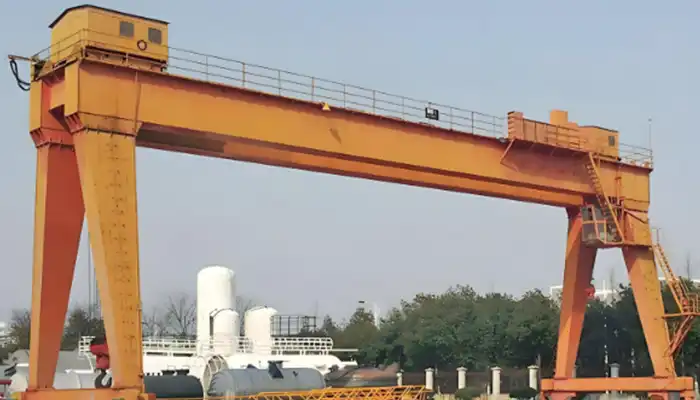
Enhanced Safety and Minimized Risk of Injury
The use of gantry cranes, especially with automated and remote control systems, significantly enhances safety in energy storage facilities by reducing the need for manual labor and minimizing the physical risks associated with handling heavy cabinets and battery modules.
- Reduced Physical Strain: Cranes take over the heavy lifting tasks that would otherwise require manual effort, which can lead to physical strain or injury. Workers no longer need to manually lift or transport large cabinets, reducing the risk of back injuries or accidents.
- Safe Handling with Precision: The crane's precise control systems ensure that cabinets are moved without risk of tipping over, dropping, or damaging sensitive components, further safeguarding both the personnel and the equipment.
- Remote Operation and Monitoring: Remote control capabilities allow operators to manage crane movements from a safe distance, avoiding potential hazards associated with operating large machinery in confined spaces.
Optimized Space Utilization in Energy Storage Facilities
Gantry cranes contribute to better space utilization within energy storage facilities by enabling the efficient movement of heavy cabinets and modules. This is particularly beneficial in facilities where space is limited or where racks and storage areas need to be accessed frequently.
- Compact Design and Flexibility: The ability of gantry cranes to operate in tight spaces allows for the optimization of floor layouts. Cranes can be installed to service multiple workstations or storage areas, facilitating efficient use of available space.
- Maximized Storage Efficiency: The efficient handling of cabinets and battery modules means that more space can be dedicated to storage rather than allowing room for manual handling or excessive movement, thus improving overall space utilization.
Cost Savings Through Efficient Operations and Reduced Manual Labor
Incorporating gantry cranes into the maintenance workflow leads to significant cost savings in both direct and indirect ways. By automating much of the handling and transport of heavy components, facilities can cut down on labor costs and improve operational efficiency.
- Labor Cost Reduction: Gantry cranes reduce the need for manual labor, which decreases the number of workers required for each maintenance task. This translates to lower staffing costs and less reliance on manual labor for heavy lifting.
- Fewer Mistakes and Damages: By using automated and precision-controlled cranes, the likelihood of errors that could result in damage to the cabinets or batteries is reduced, saving the facility money on repairs and replacements.
- Operational Efficiency: The speed and efficiency with which cranes can handle cabinets lead to reduced maintenance costs overall. Facilities spend less time on each task and can complete more work in less time, improving throughput and reducing operational expenses.
E. Long-Term Sustainability and Ease of Adapting to Future Battery Technologies
As energy storage technologies evolve, gantry cranes offer long-term sustainability by providing a scalable and flexible solution for handling new battery technologies that may emerge in the future. Their ability to adapt to changes in cabinet sizes, battery types, and maintenance needs ensures that they remain useful even as energy storage systems evolve.
- Future-Proofing Operations: Gantry cranes, especially those with adjustable capacities or modular designs, can easily be upgraded or modified to handle new types of batteries or larger systems as energy storage technologies continue to improve.
- Support for Advanced Battery Types: As more advanced and higher-capacity battery technologies are developed (e.g., solid-state batteries), the gantry crane can accommodate these innovations without needing a complete overhaul of the existing maintenance infrastructure.
- Sustainability in Operations: By reducing manual labor, improving efficiency, and enabling easier maintenance of next-generation battery technologies, gantry cranes help ensure that energy storage facilities remain sustainable and capable of supporting future energy storage needs.
In conclusion, streamlining operations with gantry cranes brings numerous benefits to energy storage facilities, from reducing downtime and enhancing safety to optimizing space usage and achieving cost savings. Their flexibility and ability to adapt to evolving technologies also ensure long-term sustainability, positioning energy storage facilities for success in the future.
Case Studies and Real-World Examples
Successful Implementation of Gantry Cranes in Energy Storage Facilities
Several energy storage facilities have successfully integrated gantry cranes into their maintenance operations, achieving significant improvements in efficiency, safety, and cost savings. These implementations showcase the practical benefits of using gantry cranes in handling large energy storage cabinets and performing routine maintenance.
Case Study 1: Large-Scale Industrial Facility
A major industrial energy storage facility located in a region with high energy demand implemented gantry cranes to handle the maintenance and replacement of energy storage cabinets housing lithium-ion batteries. The cranes were chosen for their ability to handle heavy loads and move cabinets efficiently across the facility's multiple maintenance zones.
- Results: The implementation led to a 40% reduction in downtime, as cabinets were moved quickly between removal, servicing, and reinstallation stages. Automated systems attached to the cranes allowed for precise handling of sensitive battery modules, reducing damage and improving safety.
- Key Outcome: The facility reduced maintenance-related operational delays, achieving better uptime and significantly improving the efficiency of its energy storage operations.
Case Study 2: Commercial Energy Storage Provider
A commercial provider specializing in energy storage solutions for businesses across urban areas incorporated gantry cranes in its maintenance workshops. These cranes were tasked with handling smaller energy storage units but required high maneuverability in compact spaces.
- Results: With double girder gantry cranes, the provider managed to handle a variety of cabinet sizes efficiently in a limited workshop space, leading to a 25% decrease in maintenance cycle times. The flexibility of the cranes allowed the company to manage a growing customer base with ease.
- Key Outcome: The company improved customer satisfaction by offering quicker turnaround times for battery maintenance and upgrades.
Analysis of Operational Improvements in Energy Storage Maintenance
The use of gantry cranes in energy storage facilities has led to numerous operational improvements, particularly in areas like maintenance speed, cost-effectiveness, and safety.
Maintenance Speed:
- Gantry cranes equipped with automated systems for handling and transporting energy storage cabinets have reduced the manual labor involved in the maintenance process. This has allowed facilities to complete routine maintenance faster, leading to improved system availability and fewer operational interruptions.
- Example: In one facility, gantry cranes reduced the time needed to remove and replace cabinets by 30%, directly increasing the number of maintenance cycles completed per year.
Cost-Effectiveness:
- With reduced labor costs and the increased speed of maintenance operations, many facilities have seen a significant return on investment (ROI) after integrating gantry cranes. By cutting down on the number of staff needed for manual lifting and transport, facilities can allocate resources more efficiently elsewhere.
- Example: In one case, a facility saw a 15% reduction in maintenance costs annually, due to labor savings and fewer damaged components during maintenance.
Safety Improvements:
- The introduction of gantry cranes reduces the need for workers to physically handle heavy cabinets, minimizing the risk of accidents and injuries. Remote monitoring and control systems further contribute to a safer working environment by allowing operators to control the crane from a distance, reducing exposure to potential hazards.
- Example: After installing gantry cranes, a facility reported a 40% decrease in workplace injuries related to lifting and moving heavy equipment.
Comparative Data: Facilities with and without Gantry Cranes
The following comparative data highlights the operational differences between energy storage facilities that have adopted gantry cranes and those that rely on manual labor for maintenance and cabinet handling.
| Parameter | Facility with Gantry Cranes | Facility without Gantry Cranes |
|---|---|---|
| Maintenance Cycle Time | Reduced by 30-40% | Standard cycle time (longer handling) |
| Labor Costs | 25% lower, due to reduced manual labor | Higher labor costs due to manual handling |
| Downtime During Maintenance | 25-35% less downtime | Higher downtime due to slower processes |
| Workplace Injuries | Reduced by 40% | Higher rate of manual handling injuries |
| Efficiency in Space Utilization | Maximized space efficiency (compact design) | Less optimized space utilization |
| Return on Investment (ROI) | Achieved within 1-2 years | Slower ROI due to ongoing labor expenses |
- Maintenance Cycle Time: Facilities with gantry cranes experience significantly shorter maintenance cycles, as the cranes are able to move and service cabinets faster compared to manual labor. This directly contributes to reducing overall downtime and improving the facility's operational availability.
- Labor Costs: By eliminating much of the manual labor required for cabinet handling, facilities with gantry cranes can reduce their labor costs, freeing up resources for other tasks or investments. The savings in labor costs are a major factor in justifying the investment in gantry cranes.
- Downtime During Maintenance: Facilities that use gantry cranes experience lower downtime, which is critical for energy storage facilities that provide backup power or grid support. Faster maintenance processes lead to more consistent and reliable service.
- Workplace Injuries: Facilities without gantry cranes are more likely to experience injuries related to heavy lifting and handling, as workers are required to manually move large cabinets. Gantry cranes significantly reduce these risks by automating these tasks.
- ROI: The return on investment for gantry cranes is generally faster, as the savings in labor costs and improved operational efficiency pay off quickly, typically within 1-2 years of installation. Facilities without gantry cranes may see slower ROI due to ongoing labor costs and less efficient operations.
In conclusion, case studies and comparative data demonstrate that the integration of gantry cranes into energy storage maintenance operations yields significant improvements in operational efficiency, cost savings, safety, and overall performance. Whether in large industrial facilities or smaller commercial energy storage providers, the benefits of gantry crane implementation are clear, positioning facilities for long-term success in an evolving energy landscape.
Challenges and Considerations
Initial Setup and Cost Considerations
While gantry cranes offer significant benefits, their initial setup can be a substantial investment for energy storage facilities. The cost of purchasing, installing, and integrating the crane system into the existing workflow needs to be carefully considered.
- Equipment and Installation Costs: Gantry cranes, especially double girder models with automation capabilities, are a significant capital expenditure. The costs include not only the crane system itself but also the installation of supporting infrastructure such as tracks, rails, power supplies, and control systems.
- Customization for Facility Needs: Customizing the crane system to suit specific facility requirements—such as handling various cabinet sizes or incorporating automated systems—may further increase initial costs. However, this upfront investment can be offset by long-term savings in labor and maintenance efficiency.
- Return on Investment (ROI): The ROI of gantry cranes typically becomes evident within 1-2 years through reduced labor costs, minimized downtime, and increased operational throughput. Facilities should carefully assess how soon they expect to recoup the initial investment through improved operations.
Space and Infrastructure Requirements
Integrating gantry cranes into an energy storage facility requires careful planning of space and infrastructure to ensure smooth and efficient operations.
- Space Allocation: Gantry cranes require ample space to operate effectively, especially if they are handling large, heavy cabinets. Facilities need to allocate dedicated space for crane tracks and movement paths, which can limit the available floor area for other operations.
- Building Reinforcement: Due to the weight of the cranes and the heavy loads they carry, the building structure must be capable of supporting these systems. This may require additional reinforcement of floors or ceilings to ensure the facility can handle the added weight and stress without compromising structural integrity.
- Integration with Existing Systems: The integration of gantry cranes with existing storage racks, automated systems, and battery handling equipment needs to be considereFor optimal performance, the layout of the facility should be redesigned to maximize space and crane efficiency, which may require some initial reconfiguration of storage and service areas.
Training for Crane Operators and Maintenance Staff
The successful operation of gantry cranes requires proper training for crane operators and maintenance personnel. Effective training ensures that the crane system is used safely, efficiently, and to its full potential.
- Operator Training: Crane operators must be trained not only in the basics of operating the crane but also in the specific handling requirements of energy storage cabinets and battery modules. This includes learning how to adjust the crane for different cabinet sizes, understand weight limits, and use automated controls.
- Safety Protocols: Operators must be familiar with safety protocols, such as emergency shutdown procedures, load monitoring, and safe crane maneuvering to prevent accidents. Regular safety drills should be conducted to ensure that all personnel know how to react in case of an emergency.
- Maintenance Team Training: Maintenance staff should be trained to perform routine checks on the crane system, ensuring it is in good working order. This includes understanding how to maintain crane components, troubleshoot common issues, and respond to any malfunctions that may occur during operations.
Potential Technical Challenges and Solutions
As with any complex system, there are technical challenges that may arise when using gantry cranes in energy storage facilities. However, these challenges can be addressed through careful planning and proactive solutions.
- Technical Issue 1: Crane Malfunctions and Downtime
Challenge: Gantry cranes, especially those with automated features, may experience technical issues, such as software glitches or mechanical failures, leading to downtime and delays in operations. Solution: Regular preventive maintenance, software updates, and diagnostic tools are essential to minimizing the risk of malfunctions. Implementing remote monitoring systems allows for real-time tracking of the crane's health and enables prompt action if issues arise. - Technical Issue 2: Integration with Existing Systems
Challenge: Integrating gantry cranes into an existing maintenance workflow and automation system may be challenging, especially in older facilities where infrastructure and technology may not be compatible with modern crane systems. Solution: During the planning phase, it's crucial to assess the compatibility of new crane systems with existing equipment and make necessary adjustments to the facility's automation systems. Consultation with experts in crane integration and system compatibility can help ensure seamless operation. - Technical Issue 3: Load Distribution and Accuracy
Challenge: Ensuring the crane's lifting mechanisms can handle the uneven distribution of loads—such as when energy storage cabinets are not balanced—can lead to instability or potential damage. Solution: Advanced load monitoring and control systems, including sensors and real-time feedback mechanisms, can be integrated into the crane to ensure the load is always balanced and within safe limits. Additionally, precise handling techniques, as well as operator training, can mitigate these risks.
By understanding and addressing these challenges, energy storage facilities can effectively integrate gantry cranes into their operations, maximizing the benefits while minimizing potential drawbacks. Careful planning, training, and ongoing maintenance ensure that the systems continue to perform optimally, providing long-term value to the facility.
Conclusion
Recap of Key Findings from the Study
This study highlights the significant advantages of integrating gantry cranes into energy storage maintenance operations. Key findings include:
- Increased Efficiency: Gantry cranes drastically reduce maintenance cycle times by automating the handling and transport of energy storage cabinets, leading to faster turnarounds and minimized downtime.
- Improved Safety: By minimizing manual labor and utilizing precision control systems, gantry cranes reduce the risk of injuries and improve overall safety within energy storage facilities.
- Cost Savings: Facilities that use gantry cranes experience reduced labor costs, fewer operational interruptions, and less equipment damage, resulting in substantial cost savings over time.
- Space Optimization: Cranes facilitate more efficient use of available floor space, which is essential in facilities with limited room for operations.
- Adaptability: Gantry cranes are versatile and capable of adapting to evolving battery technologies, ensuring their continued relevance as energy storage systems advance.
Importance of Gantry Cranes in Modernizing Energy Storage Maintenance
Gantry cranes play a crucial role in modernizing energy storage maintenance by automating and streamlining processes that were once manual and labor-intensive. Their ability to handle large, heavy cabinets and integrate with automated systems makes them invaluable in today's fast-paced energy sector. As energy storage demands increase and battery technologies evolve, the role of gantry cranes in ensuring efficient and safe maintenance will become even more essential. They are not only improving current operations but also setting the stage for future innovations in energy storage facility management.
Future Prospects: Evolving Technology and Its Impact on Energy Storage Operations
As energy storage technologies continue to evolve, so too will the role of gantry cranes in maintaining and servicing energy storage systems. Future advancements in battery technology—such as the development of solid-state batteries, larger-scale storage systems, and faster charging technologies—will require new solutions for handling and servicing batteries. Gantry cranes will need to adapt to these changes, offering more flexible, scalable, and automated solutions that can accommodate these new technologies.
- Smart Gantry Cranes: The future may bring even more sophisticated cranes, equipped with artificial intelligence (AI), machine learning, and enhanced automation to optimize handling and predict maintenance needs before they arise.
- Integration with Other Technologies: Gantry cranes may also be integrated into wider digital ecosystems that incorporate remote monitoring, predictive analytics, and real-time data sharing, improving overall facility performance.
The continued development of energy storage systems, paired with innovations in crane technology, will help ensure that energy storage facilities can meet the increasing demand for sustainable and reliable energy storage solutions.
Recommendations for Facilities Considering Gantry Crane Installations
For energy storage facilities considering gantry crane installations, the following recommendations are essential for ensuring successful integration:
- Evaluate Facility Needs: Carefully assess the size, capacity, and layout of your facility to determine the right crane model and configuration. Consider factors such as load capacity, space constraints, and future scalability.
- Invest in Training: Ensure that crane operators and maintenance staff receive thorough training in both the technical operation and safety protocols associated with gantry cranes. Ongoing training and safety drills are essential to maximize the benefits of the system.
- Plan for Integration: Work with experts to ensure that gantry cranes are properly integrated into existing workflows, automated systems, and facility layouts. Consider possible future upgrades to handle new battery technologies and larger energy storage systems.
- Focus on Long-Term Maintenance: Implement a regular maintenance schedule to keep gantry cranes in optimal working condition. This includes routine inspections, preventive maintenance, and software updates for automated systems.
- Consider ROI and Cost Savings: Factor in the long-term savings from reduced labor costs, faster maintenance, and improved operational efficiency when considering the initial investment in gantry cranes. Establish clear ROI expectations based on improved performance metrics.
By following these recommendations, energy storage facilities can ensure a smooth and efficient installation process, maximizing the value that gantry cranes bring to their operations while positioning themselves for success in a rapidly changing energy landscape.
Main Projects
Related Products
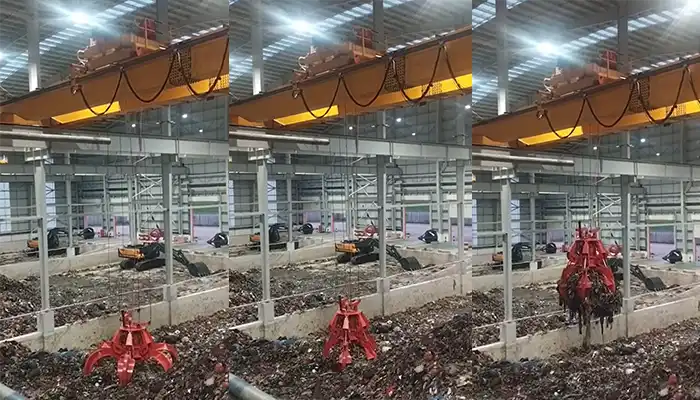
Supplied three grab bucket crane kits to Indonesia, enhancing garbage handling efficiency with high load capacity and reliable performance.
Free consultation to Confirm Parameters & Specifications and Get
Latest Crane Price & Crane Rate.
- Types of overhead cranes : _______?
- Optional: Overhead travelling crane, goliath gantry crane,Slewing jib crane, Single girder or double girder crane,small portable crane or kbk crane, etc.
- Capacity of overhead crane: _______?
- Optional: 0.25ton, 0.5 ton, 1 ton, 2 ton, 3ton, 5 ton, 10 ton,15ton, 20ton, 25 ton, 30ton,35ton, up to 550ton, etc.
- Crane span & lifting height : _______?
- Crane travelling length : _____?
- Control of overhead crane:_______?
- Optional: pendant/ remote/cabin control
- Voltage supply of overhead crane:_____?
- Eg,: 380V50/60HZ,3Phase or others,etc.
- Application/usage of crane:_______?
- Eg,: Steel mill, ,injection mold, cement,stone, concrete,granite, general manufacturing, etc.
Just leave a message via the contact form and our hoist and crane engineer will contact you with in 24working hours.
Get In Touch
